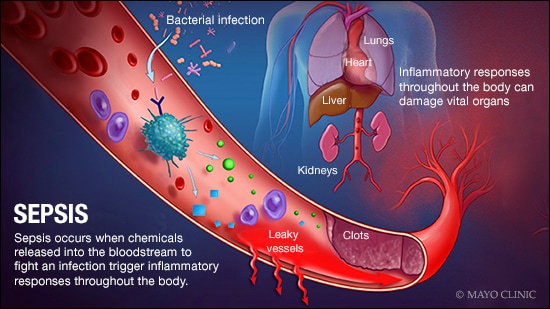Diagnosis
Doctors often order several tests to try to pinpoint underlying infection.
Blood tests
Blood samples are used to test for:
- Evidence of infection.
- Blood-clotting problems.
- Abnormal liver or kidney function.
- Lower levels of oxygen than the body needs.
- Electrolyte imbalances.
Other lab tests
Other lab tests to find the source of the infection might include samples of:
- Urine.
- Liquid from the wound.
- Mucus and saliva from the respiratory tract.
Imaging tests
If the site of infection is not readily found, your health care provider may order more tests. Some examples of imaging tests are:
- X-ray. X-rays can show infections in your lungs.
- Ultrasound. This machine uses sound waves to produce real-time images on a video screen. Ultrasound can show infections in the gallbladder and kidneys.
- Computerized tomography (CT). This machine takes X-rays from a variety of angles and combines them to show cross-sectional slices of the inside of the body. Infections in the liver, pancreas or other abdominal organs are easier to see on computed tomography (CT) scans.
- Magnetic resonance imaging (MRI). This machine uses radio waves and a strong magnet to produce cross-sectional or 3D images. It may be helpful in seeing soft tissue or bone infections.
Treatment
Early, thorough treatment raises the likelihood of recovery. People who have sepsis need close monitoring and treatment in a hospital intensive care unit. This is because people with sepsis may need lifesaving measures to stabilize breathing and heart action.
Medications
Different medications are used in treating sepsis and septic shock. They include:
- Antibiotics. Treatment with antibiotics begins as soon as possible. Broad-spectrum antibiotics, which are effective against a variety of bacteria, are often used first. When blood tests results show which germ is causing the infection, the first antibiotic may get switched out for a second one. This second one targets the germ causing the infection.
- Fluids added to veins. The use of intravenous fluids begins as soon as possible.
- Vasopressors. Vasopressors narrow blood vessels and help increase blood pressure. A vasopressor medication may be used if blood pressure is too low even after receiving fluids.
Other medications may be used, such as insulin for blood sugar levels, or painkillers.
Supportive care
People who have sepsis often get supportive care that includes oxygen. Some people may need a machine help them breathe. If a person's kidneys don't work as well because of the infection, the person may need dialysis.
Surgery
Surgery may help to remove sources of infection, such as pus, infected tissues or dead tissues.
Clinical trials
Explore Mayo Clinic studies testing new treatments, interventions and tests as a means to prevent, detect, treat or manage this condition.
